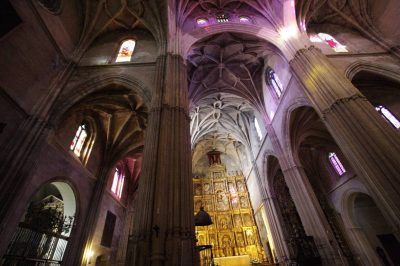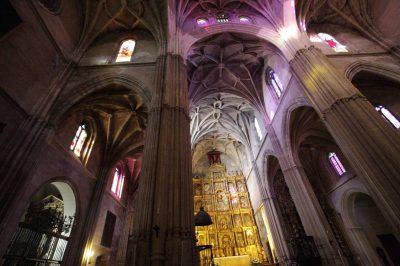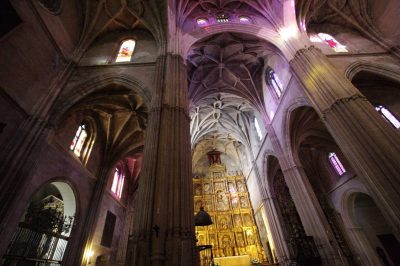This is the town’s most important church. Its construction started in 1424 and was completed in 1551. It is Gothic in style, although it has undergone subsequent additions. The late 17th century Puerta del Sol and the Sacramental chapel remain from the baroque period. The tower’s construction started in the 16th century, and the two upper sections were completed in the 19th century. It was built over the town’s former mosque and still preserves the former patio of ablutions, named Patio de los Naranjos (orange tree patio). We can observe a 6th century Visigoth calendar in one of the patio’s corners.
The church has a hall floor plan, with three naves, plus chapels between the side buttresses. Diego de Riaño created the complicated pillars and rib vault. It has a free-standing choir with a very interesting seating area (artist unknown) from the start of the 18th century. Its wonderful main altarpiece is truly outstanding, the height of the Andalusian plateresque style. It consists of one single plane, divided into five rows with four tiers, an attic tier and baldachin, designed by Juan Bautista Vázquez el Viejo. Its construction started in 1559.
The vast heritage that this church conserves is displayed in the sacred art museum, which houses works of great interest.
With regards imagery, the icon Virgen de Gracia, the town’s patron is impeccable; a medieval sculpture from the end of the 13th century or the start of the 14th century. The virgin’s collection of costumes and jewels are of incalculable worth, in a monetary, historic and sentimental sense. Other outstanding elements are the Cristo de los Desamparados, a piece dating to the 13th century, the Calvario located in the sacristy, attributed to Mercadante de Bretaña, the Inmaculada Concepción by Pedro Duque Cornejo (1719), the altar del Cristo de los Martirios, attributed to Roque de Balduque, and Cristo de la Capilla de la Encarnación, work by Gaspar del Aguila in 1649.
Outstanding paintings are the San Bartolomé altarpiece, with paintings by Pedro de Campaña towards 1545, and the Zurbarán’s representation of the apostles which seemed to serve as practice for the piece he recreated for Quito cathedral in Peru.
The most impressive pieces of silverware are the front pages of the gospel books, in gilded silver and enamel, from the start of the 15th century, the processional monstrance and a pair of candle holders by Francisco de Alfaro from the end of 16th century, as well as the magnificent collection of chalices and pyxes from every era, amounting to more than 70 pieces.
Address
Address:
Plaza del Marques de las Torres, s/n,Carmona
GPS:
37.473290092039, -5.6374858511006












